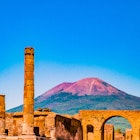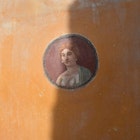
Mar 17, 2023 тЂ 6 min read

May 6, 2022 тЂ 4 min read

The new exhibition in Pompeii includes works like this Satyr and Hermaphrodite statue which has erotic undertones ТЉ Andreas Solaro/Getty Images
Itтs possibly the hottest thing to hit Pompeii since the eruption of Mt Vesuvius covered the city in flaming ash and lapilli (burning fragments of pumice stone) back in AD 79. A new exhibition, entitled тArt and Sensuality in the Houses of Pompeiiт, comprises of 70 provocative paintings, sculptures, and other decorative erotica found at the vast 66-hectare archaeological site, on show together for the first time.
Running until January 2023, the exhibition includes racy treasures such as paintings taken from Pompeiiтs lupanar (brothel), which depict the sexual acts customers were able to pick from. There is also a restored bedroom ceiling fresco of a naked Leda, the Queen of Sparta, with a swan upon her lap, depicting the god Zeus.
Organizers have said that many of the erotic finds have either been discovered during recent excavation works or were stored away secretly in Naples, Italy at the behest of King Charles VII, the Neapolitan monarch who originally paid for the excavation of the Pompeii site. Only those of proven moral standing were allowed to ever lay eyes on them.
Read more: Take a virtual drone tour of the fascinating new excavations in Pompeii

Now anyone with tickets for the exhibition canтt help but stare at the huge sculptured penis of the god Priape, found on a statue-fountain at the exhibition entrance. The artwork wasnтt made for tittering or titillation т that'll be your modern mind, according to the Director of the Archaeological Park of Pompeii, Gabriel Zuchtriegel т instead, it was a Roman symbol of fertility and would have been commonly found in atriums (private courtyards).
тIn these times of pandemic emergency and war, this exhibition seeks to be an ode to the resilience of beauty,т Zuchtriegel said at the launch of the show, тbut from a historical perspective, which helps us to understand that even in the past, art and the imagination were interwoven with social, cultural and political relationships and hierarchies.т
So what other historical perspective is set to get visitors hot under the collar? Amongst the more interesting ephemera are two medallions found on a four-wheeled Roman chariot used by prominent religious women, which was found on site last year. Both are decorated by cavorting satyrs and nymphs and are joined by a wooden chest that is embellished erotically in bronze.
Read more: Inside Pompeii's House of Lovers as it reopens to the public after 40 years

The show, which takes place in the western portico of the Large Palaestra, guides visitors through a perfect Pompeian home and allows them to see where sensual beauty would have been on display. There are intimate and erotic scenes taken from the cubicula (bedrooms) of the Villa of Carmiano, plus a cycle of faded images that depict a man and a woman having sex т believed to be used as cultural introduction to Greek erotic literature.
Visitors will also find an ephebe (male adolescent) lampadophore (тHe who bears the lampт) candleholder which would have been on display in the triclinium (formal dining room). The sculptured lamp would have provided a sly wink to Greek homoeroticism.
As well as at the show, the My Pompeii app also has a new dedicated section that allows visitors to find frescoes and other erotic artworks around the rest of the vast site, which covers more than 1500 well-preserved buildings as well as roads, everyday objects, even people.
Read more: Pompeii: get to know Italyтs legendary ruined city

But with so many phalluses and fanciful sexual imagery on display, wonтt someone think of the children? Well, the team has.
"The theme may seem difficult, but it is omnipresent in Pompeii, so it must be explained to children in one way or another,т says Zuchtriegel. Indeed, a kids' guide entitled The Centaurs of Pompeii aims to explain the subject by following a centaur called Mares as he tries to find a partner. The book then traces a number of central figures found in ancient mythology, including Ariadne, Dionysus, and Narcissus.
Entry to тArt and Sensuality in the Houses of Pompeiiт is included in the admission fee. Prices start from тЌ16 ($US17) per adult.
You might also like:
One of the oldest frescoes in Pompeii has undergone a dramatic restoration
Street food stall discovered in Pompeii reveals dining habits of Ancient Romans
Curious tales of why tourists have been returning тcursedт items to Pompeii


Mar 17, 2023 тЂ 6 min read

Feb 17, 2022 тЂ 3 min read





Oct 22, 2018 тЂ 2 min read

Jul 18, 2024 тЂ 7 min read
